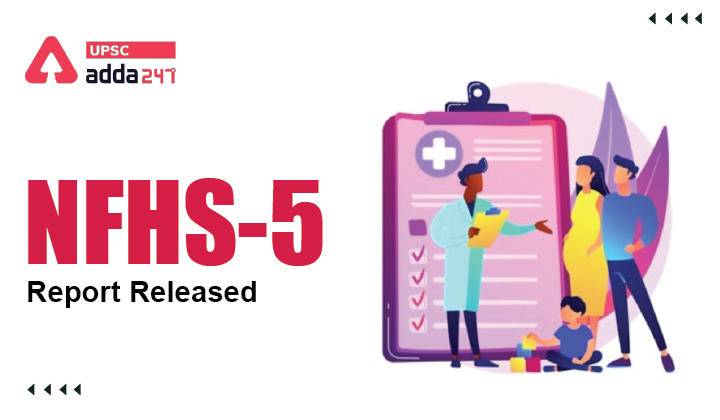Table of Contents
NFHS Report UPSC: Relevance
- GS 2: Issues relating to development and management of Social Sector/Services relating to Health, Education, Human Resources.
NFHS 5: Context
- Recently, Ministry of Health and Family Welfare has released the National Report of the fifth round of National Family Health Survey (NFHS-5).
Report of NFHS 5: Key points
- The report comprises of detailed information on key domains of population, health and family welfare and associated domains.
- The information includes: characteristics of the population; fertility; family planning; infant and child mortality; maternal and child health; nutrition and anaemia; morbidity and healthcare; women’s empowerment etc.
- The main objective of successive rounds of the NFHS has been to provide reliable and comparable data relating to health and family welfare and other emerging areas in India.
NFHS 5: New dimensions
- The scope of NFHS-5 is expanded in respect of earlier round of the survey (NFHS-4) by adding new dimensions.
- The added dimensions include:
- Death registration,
- Pre-school education,
- Expanded domains of child immunization,
- Components of micro-nutrients to children, menstrual hygiene,
- Frequency of alcohol and tobacco use,
- Additional components of non-communicable diseases (NCDs),
- Expanded age range for measuring hypertension and diabetes among all aged 15 years and above.
- These dimensions will give requisite inputs for monitoring and strengthening existing programmes and evolving new strategies for policy intervention.
- Thus, NFHS-5 provides information on important indicators which are helpful in tracking the progress of Sustainable Development Goals (SDGs) in the country.
- NFHS-4 (2015-16) estimates were used as baseline values for a large number of SDG indicators and NFHS- 5 will provide data for around 34 SDG indicators at various levels.
NFHS Report: Key findings
Total Fertility Rates (TFR)
- TFR has further declined from 2.2 to 2.0 at the national level between NFHS-4 & 5.
- There are only five States in India, which are above replacement level of fertility of 2.1.
- They are Bihar (2.98), Meghalaya (2.91), Uttar Pradesh (2.35), Jharkhand (2.26) Manipur (2.17).
Institutional births
- Institutional Births have increased substantially from 79 percent to 89 percent in India.
- Even in rural areas around 87 percent births are delivered in Institutions and same is 94 percent in urban areas.
- Institutional births increased by a maximum of 27 percentage points in Arunachal Pradesh.
- Over 91 percent of districts have more than 70 percent of births in the last 5 years that took place in health facilities.
Immunization
- In NFHS-5, more than three-fourths (77%) children age 12-23 months were fully immunized, compared with 62 percent in NFHS-4.
- Full vaccination coverage among children ranges from 57 percent in Nagaland to 95 percent in DNH & DD.
- Odisha (91%), Tamil Nadu (89%), and West Bengal (88%) also have shown relatively higher immunization coverage.
Stunting
- The level of stunting among children under 5 years has marginally declined from 38 to 36 percent for India since the last four years.
- Stunting is higher among children in rural areas (37%) than urban areas (30%) in 2019-21.
- Variation in stunting ranges from the lowest in Puducherry (20%) and highest in Meghalaya (47%).
Overweight and obesity
- Compared with NFHS-4, the prevalence of overweight or obesity has increased in most States/UTs in NFHS-5.
- At national level, it increases from 21 percent to 24 percent among women and 19 percent to 23 percent among men.
- More than a third of women in Kerala, A&N Islands, Andhra Pradesh, Goa, Sikkim, Manipur, Delhi, Tamil Nadu, Puducherry, Punjab, Chandigarh and Lakshadweep (34-46 %) are overweight or obese.
Women empowerment
- The extent to which married women usually participate in three household decisions indicates that their participation in decision making is high, ranging from 80 percent in Ladakh to 99 percent in Nagaland and Mizoram.
- Three Household decisions includes health care for herself; making major household purchases; visit to her family or relatives, among others.
- Rural (77%) and urban (81%) difference is found to be marginal.
- The prevalence of women having a bank or savings account that they use has increased from 53 to 79 percent in the last 4 years.
Clean cooking and sanitation
- Between NFHS-4 and NFHS-5, the use of clean cooking fuel (44% to 59%) and improved sanitation facilities (49% to 70%), including a hand-washing facility with soap and water (60% to 78%) have improved considerably.
NFHS 6
- NFHS-6, which is scheduled to be conducted during 2023-24, propose to cover various new domain areas that includes data about COVID-19, Director Benefit Transfers (DBT) under various welfare schemes, Migration, digital literacy, marital choice financial inclusion among women, quality of family planning programme, among others.
- Unlike in previous rounds, NFHS-6 will adopt Urban Frame Survey (UFS, 2012-17) of NSO, MoSPI as a sampling frame for urban area.
Rural Health Statistics Publication
- Ministry of Health & Family Welfare (MoHFW) has been publishing Rural Health Statistics (RHS) publication since the year 1992.
- The publication contains important and crucial information related to Human Resources and Health Infrastructure available in the Public Health facilities.
- As per RHS 2020-21, there are 157819 Sub Centres (SC), 30579 Primary Health Centres (PHCs) and 5951 Community Health Centres (CHCs) respectively functioning in rural and urban areas of the country.
Rural Health Statistics: Key parameters
| Name of the Indicators | Year 2013-14 (as on 31st March 2014) | Year 2020-21 (as on 31st March 2021) | %age Growth of 2020-21 w.r.t 2013-14 |
| No. of SCs | 152326 | 157819 | 3.6 |
| No. of PHCs | 25020 | 30579 | 22.2 |
| No. of CHCs | 5363 | 5951 | 11.0 |
| Doctor at PHCs | 27335 | 38525 | 40.9 |
| Total Specialist at CHCs | 4091 | 5760 | 40.8 |
Read current affairs for UPSC





 TSPSC Group 1 Question Paper 2024, Downl...
TSPSC Group 1 Question Paper 2024, Downl...
 TSPSC Group 1 Answer key 2024 Out, Downl...
TSPSC Group 1 Answer key 2024 Out, Downl...
 UPSC Prelims 2024 Question Paper, Downlo...
UPSC Prelims 2024 Question Paper, Downlo...
